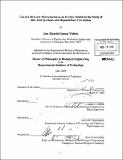| dc.contributor.advisor | Linda G. Griffith and Steven R. Tannenbaum. | en_US |
| dc.contributor.author | Llamas Vidales, Jose Ricardo | en_US |
| dc.contributor.other | Massachusetts Institute of Technology. Dept. of Biological Engineering. | en_US |
| dc.date.accessioned | 2011-02-23T14:32:34Z | |
| dc.date.available | 2011-02-23T14:32:34Z | |
| dc.date.copyright | 2009 | en_US |
| dc.date.issued | 2009 | en_US |
| dc.identifier.uri | http://hdl.handle.net/1721.1/61226 | |
| dc.description | Thesis (Ph. D.)--Massachusetts Institute of Technology, Dept. of Biological Engineering, 2009. | en_US |
| dc.description | Cataloged from PDF version of thesis. | en_US |
| dc.description | Includes bibliographical references (p. 149-165). | en_US |
| dc.description.abstract | The liver regulates a myriad of vital functions including bile acid synthesis, hepatobiliary circulation, cholesterol homeostasis, drug metabolism, etc. This thesis focuses on the use of a 3D in vitro model of liver to study the effects of compounds and culture conditions on hepatobiliary transport and bile acid synthesis. In order to achieve this goal, protocols were developed to perform hepatic transport studies of bile acids in perfused 3D primary rat hepatocyte cultures. An established 2D sandwich culture model was used as a foundation for evaluation of variations in protocol parameters including culture medium composition and assay incubation times. In 2D sandwich cultures, dexamethasone (DEX) was essential for the formation of canalicular networks, whereas epidermal growth factor (EGF) disrupted the formation of these networks. Strikingly, EGF promotes cellular re-polarization and canalicular network formation in perfused 3D cultures, in contrast to its effect on 2D cultures. Perfused 3D cultures were found to have greater bile acid transport capabilities and closer to in vivo expression of certain liver transporters than 2D sandwich cultures on day 7. Perfused 3D cultures also had greater bile acid synthesis on day 7 than 2D cultures, however this was inhibited by EGF in both cultures. A numerical model was also developed for the reduction of experimental measurements necessary to determine pharmacokinetic parameters of hepatic transport, thus allowing for quantitative comparison of the effects of different culture conditions and culture platforms on transporter activity. The result of this thesis is the adaptation of a system for the study of hepatic transport and bile acid synthesis to 3D cultures. This system has also been previously shown to maintain other liver functions such as drug metabolism, and the work of this thesis thus allows for the concerted study of all these functions and potentially others. | en_US |
| dc.description.statementofresponsibility | by Jose Ricardo Llamas Vidales. | en_US |
| dc.format.extent | 234 p. | en_US |
| dc.language.iso | eng | en_US |
| dc.publisher | Massachusetts Institute of Technology | en_US |
| dc.rights | MIT theses are protected by copyright. They may be viewed, downloaded, or printed from this source but further reproduction or distribution in any format is prohibited without written permission. | en_US |
| dc.rights.uri | http://dspace.mit.edu/handle/1721.1/7582 | en_US |
| dc.subject | Biological Engineering. | en_US |
| dc.title | Use of a 3D liver microreactor as an in vitro model for the study of bile acid synthesis and hepatobiliary circulation | en_US |
| dc.title.alternative | Use of a three-dimensional liver microreactor as an in vitro model for the study of bile acid synthesis and hepatobiliary circulation | en_US |
| dc.type | Thesis | en_US |
| dc.description.degree | Ph.D. | en_US |
| dc.contributor.department | Massachusetts Institute of Technology. Department of Biological Engineering | |
| dc.identifier.oclc | 701538651 | en_US |
